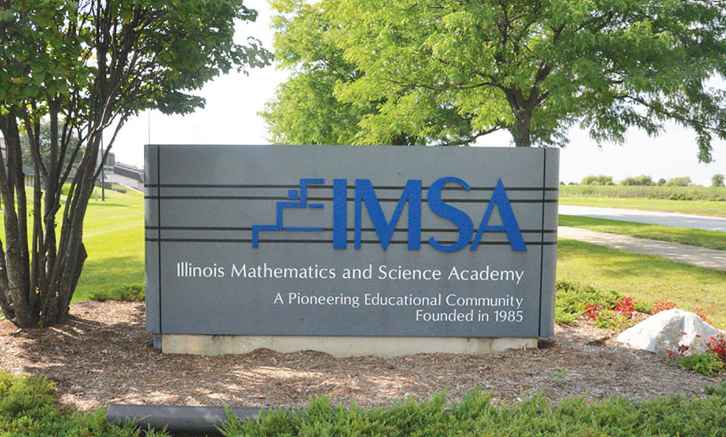The news is out: IMSA is accepting applications for the 2023–2024 school year for up to six out-of-state students.
This project is not new, as preparations have been underway since 2017 when IMSA began to work on a plan for building a new residential facility for the addition of tuition-paying students. By 2018, IMSA was approved to expand by Illinois Senate Bill 2939, allowing tuition-paying, out-of-state students to encompass 25% of its enrollment. Research was conducted on specifics for recruiting, tuition, and other related aspects of enrollment for these students, and a construction estimate was made on building a 200-bed residential facility in 2019. After COVID, plans continued with a reevaluation of the construction plan in 2021 and a plan for a small pilot group finalized in 2022.
This pilot program has raised many questions in the IMSA community. To answer a few of these, The Acronym held an interview with Dr. Evan Glazer, IMSA President.
Will this affect the enrollment of Illinois students?
It is important to note that the enrollment of Illinois students will not be affected. Dr. Glazer stated that “We’re not adding students at the expense of reducing the opportunity for Illinois students. We’re adding more students.”
Dr. Glazer has also previously mentioned to The Acronym that “legislation says that IMSA enrollment should always be at least 75% Illinois students,” so adding out-of-state students to the IMSA student body will not affect the enrollment of Illinois students at IMSA.
What is the current plan with these new facilities? What is the funding going towards?
The shorter-term goal of this program is to fund the building of 1508, a new 200-bed residential facility estimated to cost $30 million. $15 million has been allocated from the state of Illinois to put towards this project, but the remaining $15 million is up for IMSA to acquire by other means. IMSA is planning to obtain a portion of these funds with tuition-paying, out-of-state students. The ultimate goal is to accumulate the funding to get rid of the individual residential facilities and create one comprehensive residential facility.
This facility would be a large square with a covered courtyard in the center and three floors. The center courtyard would be for common use, while the first floor would be for students’ residential needs including resources such as recreational areas, a dance studio, study lounges, a food preparation area, exercise facilities, and laundry rooms. The second and third floors would be for student living (i.e., dorms).
The creation of 1508 is the first step in that process.
How long after the funds are acquired will a new residential facility be constructed?
Constructing a new residential facility (i.e., 1508) will take between 3–5 years once funding is acquired because of administrative processes that must occur before actual construction can begin.
According to Dr. Glazer, these processes include working with an architect, bidding with construction companies for pricing, and having the Illinois Capital Development Board create arrangements to start the contract and work through all the details.
The first step towards implementing this process is proving to the state that IMSA has the funding, and that will require some fundraising and working with financial institutions to provide some financing.
How is the application process going?
As of January 18, 2022, there have been fourteen out-of-state applications started. This is 56% of IMSA’s ultimate goal of obtaining 25 applications by the deadline February 8, 2023, which is the same deadline given to Illinois students.
Not wanting to get too many applicants with only six spots available, IMSA has not been utilizing a hard marketing approach. Most information about the application opening has been shared through word of mouth, although they have sent a press release to newspapers and the IMSA Alumni Association.
IMSA is striving for 25 applicants, despite its six-student enrollment cap, because only some applicants will qualify, and of those who do, only an estimated half will accept admission, according to their research. The application and review process for out-of-state students mirrors that of in-state students, both requiring the same standard of academic excellence and other qualifying factors.
Why six students?
Six students were decided upon because the pilot program plans to eventually accommodate around 12-14 out-of-state students across the three grades. Six multiplied by three is 18, not 14, but students leaving to return to their home schools must be accounted for and since 1 in every 6 students leave between 10th-12th grade, on average, having these ‘extra’ students is necessary to average at their 12-14-student goal.
More important is to increase demand for out-of-state students in the future. The ultimate goal is to enroll 50 out-of-state students every year once a new facility is built, although the funding for this facility may take around 5 years to obtain.
Where will these new students live before the new residential facility is built?
IMSA will retrofit two residential halls to accommodate these new students, specifically the Residential Life Leadership apartments (i.e., the apartments of the supervisors for the Resident Counselors, or RCs). The people who previously lived in these apartments will be relocated to either unused RC apartments or to nearby off-campus housing.
How will these students be accommodated during extended weekends (short, three-day weekends)?
During long breaks such as winter or spring break, all students will go home. During shorter extended weekends, IMSA will recommend a service to families where they can obtain a local host family. This will be available to not only these students but downstate Illinois students as well. The service will be promoted to IMSA families so they can sign up as a local host, too.
This service will not only be applicable to extended weekends, however. It will also be offered during any other circumstances where a student would need to leave the IMSA property for a shorter period of time, such as when they must go home due to a COVID infection.
This service would involve a fee that would be directly transferable to the family who housed the students for their financial commitments in preparing meals and the like.
Will out-of-state students always have to pay full tuition?
As of now, out-of-state students will have to pay full tuition. This will continue to be true until the funds are available to start the process of creating a new residential facility. Over time, Dr. Glazer anticipates that the same financial tier model that is used for in-state students will be used for out-of-state students as well so that some students pay less based on what their families can afford.
Will admission ever be extended to international students?
As of now, IMSA will not extend admission to international students during the full academic year. The primary reason for this is visa circumstances. Visas are currently only permissible for a year, so international students would not be able to have the full 3-year IMSA experience. Instead, international students can come to IMSA during the summer programs or potentially as a short-term exchange program in the future.






Be the first to comment on "Questions About IMSA Enrolling Out-of-State Students: Answered"